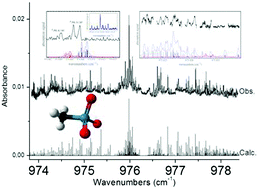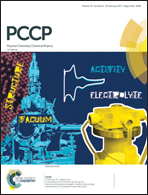Characterising molecules for fundamental physics: an accurate spectroscopic model of methyltrioxorhenium derived from new infrared and millimetre-wave measurements†
Abstract
Precise spectroscopic analysis of polyatomic molecules enables many striking advances in physical chemistry and fundamental physics. We use several new high-resolution spectroscopic devices to improve our understanding of the rotational and rovibrational structure of methyltrioxorhenium (MTO), the achiral parent of a family of large oxorhenium compounds that are ideal candidate species for a planned measurement of parity violation in chiral molecules. Using millimetre-wave and infrared spectroscopy in a pulsed supersonic jet, a cryogenic buffer gas cell, and room temperature absorption cells, we probe the ground state and the Re![[double bond, length as m-dash]](https://www.rsc.org/images/entities/char_e001.gif) O antisymmetric and symmetric stretching excited states of both CH3187ReO3 and CH3185ReO3 isotopologues in the gas phase with unprecedented precision. By extending the rotational spectra to the 150–300 GHz range, we characterize the ground state rotational and hyperfine structure up to J = 43 and K = 41, resulting in refinements to the rotational, quartic and hyperfine parameters, and the determination of sextic parameters and a centrifugal distortion correction to the quadrupolar hyperfine constant. We obtain rovibrational data for temperatures between 6 and 300 K in the 970–1015 cm−1 range, at resolutions down to 8 MHz and accuracies of 30 MHz. We use these data to determine more precise excited-state rotational, Coriolis and quartic parameters, as well as the ground-state centrifugal distortion parameter DK of the 187Re isotopologue. We also account for hyperfine structure in the rovibrational transitions and hence determine the upper state rhenium atom quadrupole coupling constant eQq′.
O antisymmetric and symmetric stretching excited states of both CH3187ReO3 and CH3185ReO3 isotopologues in the gas phase with unprecedented precision. By extending the rotational spectra to the 150–300 GHz range, we characterize the ground state rotational and hyperfine structure up to J = 43 and K = 41, resulting in refinements to the rotational, quartic and hyperfine parameters, and the determination of sextic parameters and a centrifugal distortion correction to the quadrupolar hyperfine constant. We obtain rovibrational data for temperatures between 6 and 300 K in the 970–1015 cm−1 range, at resolutions down to 8 MHz and accuracies of 30 MHz. We use these data to determine more precise excited-state rotational, Coriolis and quartic parameters, as well as the ground-state centrifugal distortion parameter DK of the 187Re isotopologue. We also account for hyperfine structure in the rovibrational transitions and hence determine the upper state rhenium atom quadrupole coupling constant eQq′.


 Please wait while we load your content...
Please wait while we load your content...